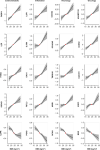Conventional and genetic associations of adiposity with 1463 proteins in relatively lean Chinese adults
- PMID: 37676424
- PMCID: PMC10570181
- DOI: 10.1007/s10654-023-01038-9
Conventional and genetic associations of adiposity with 1463 proteins in relatively lean Chinese adults
Abstract
Adiposity is associated with multiple diseases and traits, but little is known about the causal relevance and mechanisms underlying these associations. Large-scale proteomic profiling, especially when integrated with genetic data, can clarify mechanisms linking adiposity with disease outcomes. We examined the associations of adiposity with plasma levels of 1463 proteins in 3977 Chinese adults, using measured and genetically-instrumented BMI. We further used two-sample bi-directional MR analyses to assess if certain proteins influenced adiposity, along with other (e.g. enrichment) analyses to clarify possible mechanisms underlying the observed associations. Overall, the mean (SD) baseline BMI was 23.9 (3.3) kg/m2, with only 6% being obese (i.e. BMI ≥ 30 kg/m2). Measured and genetically-instrumented BMI was significantly associated at FDR < 0.05 with levels of 1096 (positive/inverse: 826/270) and 307 (positive/inverse: 270/37) proteins, respectively, with FABP4, LEP, IL1RN, LSP1, GOLM2, TNFRSF6B, and ADAMTS15 showing the strongest positive and PON3, NCAN, LEPR, IGFBP2 and MOG showing the strongest inverse genetic associations. These associations were largely linear, in adiposity-to-protein direction, and replicated (> 90%) in Europeans of UKB (mean BMI 27.4 kg/m2). Enrichment analyses of the top > 50 BMI-associated proteins demonstrated their involvement in atherosclerosis, lipid metabolism, tumour progression and inflammation. Two-sample bi-directional MR analyses using cis-pQTLs identified in CKB GWAS found eight proteins (ITIH3, LRP11, SCAMP3, NUDT5, OGN, EFEMP1, TXNDC15, PRDX6) significantly affect levels of BMI, with NUDT5 also showing bi-directional association. The findings among relatively lean Chinese adults identified novel pathways by which adiposity may increase disease risks and novel potential targets for treatment of obesity and obesity-related diseases.
Keywords: Body mass index; Drug discovery; East Asians; Mendelian randomization analysis; Obesity; Proteomics.
© 2023. The Author(s).
Conflict of interest statement
None of the authors have any conflict of interest in relation to this report.
Figures




References
MeSH terms
Substances
Grants and funding
- MC_UU_00017/1/MRC_/Medical Research Council/United Kingdom
- 202922/Z/16/Z/WT_/Wellcome Trust/United Kingdom
- C16077/A29186/CRUK_/Cancer Research UK/United Kingdom
- 29186/CRUK_/Cancer Research UK/United Kingdom
- 18/23/33512/BHF_/British Heart Foundation/United Kingdom
- MC_UU_12026/2/MRC_/Medical Research Council/United Kingdom
- 202922/WT_/Wellcome Trust/United Kingdom
- 104085/Z/14/Z/WT_/Wellcome Trust/United Kingdom
- 212946/WT_/Wellcome Trust/United Kingdom
- MC_PC_14135/MRC_/Medical Research Council/United Kingdom
- CH/1996001/9454/BHF_/British Heart Foundation/United Kingdom
- C500/A16896/CRUK_/Cancer Research UK/United Kingdom
- 212946/Z/18/Z/WT_/Wellcome Trust/United Kingdom
- MC_U137686851/MRC_/Medical Research Council/United Kingdom
- 088158/Z/09/Z/WT_/Wellcome Trust/United Kingdom
- 088158/WT_/Wellcome Trust/United Kingdom
- 104085/WT_/Wellcome Trust/United Kingdom
LinkOut - more resources
Full Text Sources
Research Materials
Miscellaneous

